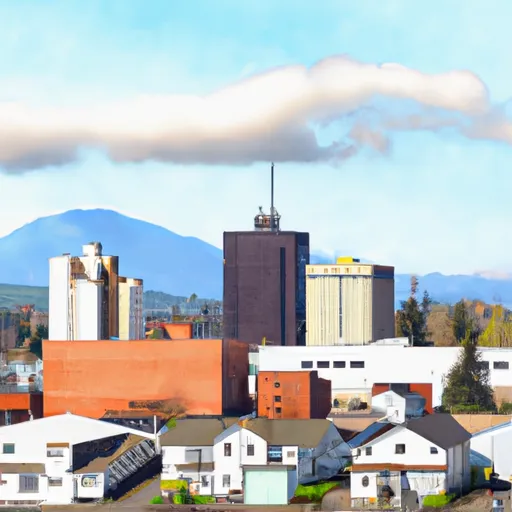-
 Snoflo Premium
Snoflo Premium
Get unlimited access to all our content
With no Ad interruptions! - Start Your Free Trial Login with existing account
Vaughn
Eden Index
Climate
7.8
•
Recreation
4.5
•
Community
2.8
•
Safeguard
5.4/10

Located in Pierce County, Washington, Vaughn is a small unincorporated community with a population of around 600 people. Situated on the western shore of the Key Peninsula, Vaughn boasts a mild maritime climate characterized by cool, wet winters and warm, dry summers. The area experiences an average annual rainfall of 50 inches. Mild temperatures make it an ideal destination for year-round outdoor activities.
Hydrologically, Vaughn is surrounded by the waters of Puget Sound, with Filucy Bay to the west and Vaughn Bay to the east. These bays provide abundant opportunities for outdoor enthusiasts. Fishing enthusiasts can enjoy both saltwater and freshwater fishing, with a variety of species like salmon, trout, and shellfish available. The calm waters of the bays also make them perfect for kayaking, paddleboarding, and boating.
Additionally, Vaughn is surrounded by lush forests and natural parks, such as Penrose Point State Park and Joemma Beach State Park. These parks offer hiking trails, picnic areas, and camping facilities, allowing visitors to immerse themselves in the beauty of the Pacific Northwest's nature. With its picturesque setting and plethora of recreational opportunities, Vaughn is a haven for those seeking outdoor adventures and a tranquil escape from the city.
What is the Eden Index?
The Snoflo Eden Index serves as a comprehensive rating system for regions, evaluating their desirability through a holistic assessment of climate health, outdoor recreation opportunities, and natural disaster risk, acknowledging the profound impact of these factors on livability and well-being.
Climate Health Indicator (CHI): 7.8
Vaughn receives approximately
1344mm of rain per year,
with humidity levels near 88%
and air temperatures averaging around
11°C.
Vaughn has a plant hardyness factor of
8, meaning
plants and agriculture in this region tend to thrive here all year round.
By considering the ideal temperature range, reliable water supplies, clean air, and stable seasonal rain or snowpacks, the Climate Health Indicator (CHI) underscores the significance of a healthy climate as the foundation for quality living.
A healthy climate is paramount for ensuring a high quality of life and livability in a region, fostering both physical well-being and environmental harmony. This can be characterized by ideal temperatures, reliable access to water supplies, clean air, and consistent seasonal rain or snowpacks.
Weather Forecast
Streamflow Conditions
Puget Sound
Area Rivers
Puget Sound
Snowpack Depths
Puget Sound
Reservoir Storage Capacity
Puget Sound
Groundwater Levels
Recreational Opportunity Index (ROI): 4.5
The Recreational Opportunity Index (ROI) recognizes the value of outdoor recreational options, such as parks, hiking trails, camping sites, and fishing spots, while acknowledging that climate plays a pivotal role in ensuring the comfort and consistency of these experiences.
Access to outdoor recreational opportunities, encompassing activities such as parks, hiking, camping, and fishing, is crucial for overall well-being, and the climate plays a pivotal role in enabling and enhancing these experiences, ensuring that individuals can engage in nature-based activities comfortably and consistently.
Camping Areas
| Campground | Campsites | Reservations | Toilets | Showers | Elevation |
|---|---|---|---|---|---|
| Camp Murray Beach Military | None | 239 ft | |||
| Twanoh State Park | 47 | 46 ft | |||
| Joemma Beach State Park | 19 | 86 ft | |||
| Scenic Beach State Park | 52 | 214 ft | |||
| Jarrell Cove State Park | None | 50 ft | |||
| Kopachuck State Park | 21 | 234 ft | |||
| Illahee State Park | 23 | 254 ft | |||
| Seal Rock | 41 | 228 ft | |||
| Fort Lewis Military | None | 254 ft | |||
| Dosewallips State Park | 125 | 20 ft |
Nearby Ski Areas
Catastrophe Safeguard Index (CSI):
The Catastrophe Safeguard Index (CSI) recognizes that natural disaster risk, encompassing floods, fires, hurricanes, and tornadoes, can drastically affect safety and the overall appeal of an area.
The level of natural disaster risk in a region significantly affects safety and the overall livability, with climate change amplifying these risks by potentially increasing the frequency and intensity of events like floods, fires, hurricanes, and tornadoes, thereby posing substantial challenges to community resilience and well-being.
Community Resilience Indicator (CRI): 2.8
The Community Resilience Indicator (CRI) recognizes that education, healthcare, and socioeconomics are crucial to the well-being of a region. The CRI acknowledges the profound impact of these elements on residents' overall quality of life. By evaluating educational resources, healthcare accessibility, and economic inclusivity, the index captures the essential aspects that contribute to a thriving community, fostering resident satisfaction, equity, and social cohesion.

